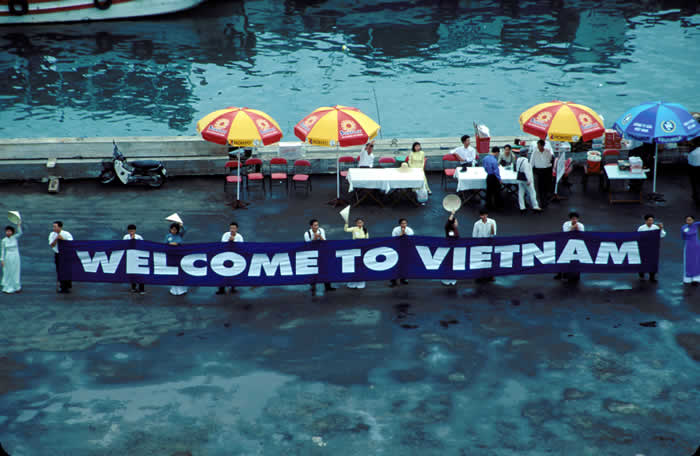越南拥有令人惊叹的自然美景和丰富的文化遗产,吸引着世界各地的冒险家踏上徒步探险之旅,穿越其令人惊叹的风景。从云雾缭绕的山脉到青翠的山谷和原始的海岸线,这个东南亚瑰宝提供了一系列适合各种技能水平的徒步旅行者的步道。无论您是经验丰富的徒步旅行者还是寻求难忘冒险的新手,这本综合指南都将为您提供必要的提示和见解,让您的旅程更加精彩。 越南徒步体验 真正了不起。
越南徒步的最佳时间
季节性考虑因素
越南多样化的气候和地形意味着理想的徒步季节会根据您计划探索的地区而有所不同。以下是开始徒步旅行的最佳时间的详细信息:
- 越南北部:十月至四月之间凉爽干燥的月份非常适合在沙巴、河江和黄连山等北部地区徒步旅行。避免夏季五月至八月,此时强降雨会使小径变得湿滑且具有挑战性。
- 越南中部:越南中部的沿海地区和高原,包括顺化、岘港和安南山脉,二月至八月提供最佳的徒步条件,天气温暖干燥。
- 越南南部:11 月至 4 月的旱季是中部高地和湄公河三角洲等南部地区徒步旅行的黄金时间。
节日和文化活动
越南充满活力的文化日历也在确定徒步旅行的最佳时间方面发挥了作用。许多当地节日和庆祝活动在春季和秋季举行,为您提供独特的机会沉浸在传统习俗和见证迷人的文化习俗中。
避开旅游旺季
为了享受更宁静、更少拥挤的徒步体验,请考虑在旅游旺季之外规划您的旅行。七月和八月往往是最繁忙的月份,许多国际游客涌向萨帕和安南山脉等热门徒步目的地。
越南徒步必备装备
鞋类
投资一双好的登山靴或鞋子对于在越南获得舒适和安全的徒步体验至关重要。寻找具有坚固鞋底、脚踝支撑和防水材料的鞋子,以应对不同的地形和潜在的潮湿条件。
背包
选择一个合适的背包,有足够的空间来携带水、零食、额外的衣服和基本急救用品等必需品。选择带有衬垫肩带和腰带的背包,可以均匀分布重量并减少背部压力。
衣服
分层穿搭是在越南徒步冒险中保持舒适的关键。包装轻便、吸湿排汗的底层、绝缘中间层和防水外壳,以防风雨。不要忘记带上帽子、太阳镜和防晒服,以免暴露在热带阳光下。
水合作用和营养
在越南经常潮湿且充满挑战的条件下徒步旅行时,保持水分和精力至关重要。携带一个可再填充的水瓶,并考虑购买一个水袋以进行长途跋涉。带上混合干果、能量棒和干果等高能量零食,为您的冒险之旅提供能量。
导航和安全装置
虽然越南的许多徒步路线都有清晰的标记,但携带地图、指南针和 GPS 设备(或支持 GPS 的智能手机)进行导航还是必不可少的。口哨、头灯或手电筒以及基本的急救箱也应该成为您的装备清单的一部分。
摄影器材
越南迷人的风景和充满活力的文化使其成为摄影师的天堂。考虑带上相机、额外的电池或移动电源,以及防雨罩或干燥袋等防护装备,以捕捉那些难忘的时刻。
越南的热门徒步目的地
沙巴和黄连山
沙巴位于越南西北部山区,是徒步旅行的圣地,可以欣赏到梯田、少数民族村庄和高耸山峰的壮丽景色。黄连山是一座与中国接壤的崎岖山脉,为穿越原始森林和偏远山谷的徒步旅行提供了具有挑战性但又有益的机会。
河江和喀斯特地质公园
越南北部的河江省以其超凡脱俗的石灰岩喀斯特地貌景观而闻名,是徒步旅行者的天堂。探索联合国教科文组织世界地质公园同文喀斯特高原地质公园,见证独特的岩层、深邃的峡谷和传统的少数民族社区。
中央高地
越南中部高地,包括林同省、多乐省和昆嵩省,拥有崎岖的山脉、翠绿的山谷和多元的少数民族文化。徒步穿越这一地区,您将穿过咖啡种植园、古老的森林和传统的村庄,以独特的方式一睹越南的文化。
湄公河三角洲
虽然徒步旅行经常被忽视,但越南南部的湄公河三角洲提供了欣赏该国乡村景观的独特视角。探索错综复杂的运河网络、郁郁葱葱的果园和熙熙攘攘的水上市场,同时徒步穿越传统村庄,体验该地区丰富的农业遗产。
越南徒步安全提示
聘请当地导游
虽然在越南可以独立徒步,但聘请知识渊博的当地导游可以显着提高您的安全和整体体验。指南不仅提供必要的导航和口译服务,还提供对当地习俗、文化和潜在危险的宝贵见解。
尊重踪迹标记和限制
越南的徒步路线通常都有清晰的标记,有标志和标记指示正确的路径。尊重这些标记并遵循指定路线至关重要,以避免迷路或误入禁区。
检查天气状况
越南的热带气候会带来天气突变,包括强降雨、雷暴,甚至山区发生山体滑坡。在开始徒步旅行之前,请查看当地天气预报并做好相应调整计划的准备。
保持水分和营养
在越南经常潮湿的热带环境中徒步旅行可能对体力要求很高。确保喝大量的水并定期吃零食和膳食来补充能量,以避免脱水和疲劳。
尊重野生动物和自然环境
越南拥有多种野生动物和脆弱的生态系统。徒步旅行者应尊重这些自然环境,留在指定的步道上,遵守“不留痕迹”原则,并避免对当地动植物群进行任何互动或干扰。
携带紧急联系人和通讯设备
在偏远地区徒步时,必须携带紧急联系信息、充电的手机或卫星通讯设备、口哨或信号镜,以备紧急或意外情况发生。
越南的导游徒步与独立徒步
导游徒步旅行的优点
聘请信誉良好的徒步导游或参加有组织的团体旅游有很多好处,特别是对于初次游客或冒险前往偏远地区的游客来说。导游提供宝贵的当地知识、导航专业知识和文化见解,确保更安全、更丰富的徒步体验。
- 安全和导航:经验丰富的导游熟悉地形、潜在危险和天气模式,减少迷路或遇到意外情况的风险。
- 文化沉浸:导游可以促进与当地社区的有意义的互动,深入了解他们的习俗、传统和生活方式,增强您的文化理解。
- 后勤保障:跟团旅游通常包括交通、住宿和膳食安排,让您专注于徒步体验。
独立徒步的好处
对于经验丰富的徒步旅行者或寻求更多自助冒险的人来说,越南的独立徒步旅行提供了一种自由和灵活性的感觉。然而,做好充分准备并采取必要的预防措施至关重要。
- 灵活性和定制化:独立徒步旅行允许您设定自己的步调、选择路线并根据您的喜好和能力定制您的体验。
- 孤独与沉浸:独自探索人迹罕至的地方可以提供与自然更深入的联系,并在偏远地区提供更身临其境的体验。
- 成本效益:独立徒步旅行可能更具成本效益,因为您可以避免与导游或团体套餐相关的费用。
在越南徒步旅行时为天气做好准备
越南多样的地形和气候意味着天气条件可能会因地区和一年中的时间而有很大差异。在越南徒步旅行时,必须为潜在的天气变化做好准备,以确保安全和愉快的体验。
- 季节性考虑因素:越南经历明显的干湿季节,北部通常从 11 月到 2 月经历寒冷的冬季,从 6 月到 8 月经历炎热的夏季。顺化和会安等中部地区在 9 月至 12 月期间可能会出现大雨,而南部地区则全年炎热潮湿。
- 分层服装:包装可以分层的轻巧,摄取水分的衣服是适应不断变化的天气条件的关键。通过携带温暖的外套或羊毛准备在山区突然下降。
- 雨具:鉴于越南倾向于下雨的倾向,优质的雨衣,防水裤子和坚固的伞可以帮助您在意外倾盆大雨中保持干燥。快速干燥的衣服和防水鞋类对于舒适也是必不可少的。
- 防晒:越南的热带阳光可能是强烈的,尤其是在较高的海拔地区。不要忘记打包防晒霜,太阳镜,宽桥的帽子和带有SPF的润唇膏,以保护您的皮肤免受紫外线的侵害。
- 水合:在越南炎热潮湿的气候中,保持水分至关重要。携带充足的水或水过滤系统,以确保沿徒步路线获得清洁的饮用水。
越南徒步文化礼仪
尊重当地习俗、传统和文化规范至关重要 在越南徒步旅行 促进与社区的积极互动并尽量减少任何无意的冒犯。了解并遵守文化礼仪可以增强您的整体徒步体验,并促进游客和当地人之间的相互尊重。
- 着装要求:参观农村地区或少数民族村庄时,出于对当地习俗的尊重,衣着得体很重要。避免穿着暴露的衣服或沙滩装,并选择遮盖肩膀和膝盖的保守服装。
- 问候:微笑并微微鞠躬打招呼当地人是越南的常见做法。学习一些基本的越南语短语,例如 “你好” (你好)和 “谢谢” (谢谢)对您的盛情款待表示感谢。
- 脱鞋:在许多越南家庭和寺庙中,习惯在进入之前脱鞋以保持内部清洁。参观当地住宅或圣地时遵循这一做法以表示尊重。
- 送礼:在越南文化中,向主人或导游赠送纪念品、小吃或水果等小礼物是一种善意的表现。避免赠送与厄运相关的物品,例如刀子或黑色物体。
- 饮食礼仪:与当地人一起用餐时,请等待最年长或最年长的人开始用餐后再开始。尊重地使用筷子,避免将它们直立插入米饭中,并对所提供的食物表示感谢。
- 摄影许可:在拍摄个人照片之前一定要征求许可,尤其是在农村或土著社区。尊重他们的隐私和文化信仰,未经同意不得进行侵入性摄影。
越南徒步的健康注意事项
保持良好的健康和卫生习惯至关重要 在越南徒步旅行 预防疾病并确保旅途安全。从疫苗接种到昆虫防护,采取积极主动的措施可以帮助您保持健康并充分享受徒步冒险。
- 疫苗接种:前往越南之前,请咨询医疗保健提供者或旅行医学专家,接受推荐的疫苗接种,例如甲型和乙型肝炎、伤寒、破伤风和日本脑炎。对于某些地区,疟疾预防也可能是必要的。
- 昆虫防护:越南是可传播登革热和疟疾等疾病的蚊子的家园。使用含有避蚊胺的驱虫剂,穿长袖衣服和长裤,并在蚊帐下睡觉,以尽量减少被叮咬的风险。
- 食品和水安全:避免胃肠道疾病,坚持使用瓶装或开水的水,并仅食用热食的食物。要谨慎对可能被污染的水洗涤的生或不甲型水果和蔬菜谨慎。
- 太阳安全:通过定期涂抹防晒霜,在高峰时间寻求阴影并保持水分,来保护自己免受晒伤和热有关疾病的侵害。耗尽耗尽和脱水可能是严重的问题,尤其是在艰苦的跋涉期间。
- 急救套件:打包一个基本的急救套件,其中包括粘合剂绷带,防腐湿巾,止痛药,抗diarrheal药物和任何个人处方。包括特定于您的医疗需求或预先存在的条件的项目。
- 高度疾病:如果在SAPA或Hoang Lien Son Moutains等高海拔地区徒步旅行,请注意高度疾病的症状并逐渐适应以降低风险。保持良好的水分,避免饮酒,并在出现严重症状时降临。
在越南进行徒步旅行的预算
与其他目的地相比,越南徒步旅行可能是预算友好的冒险,提供了一系列适合不同偏好和财务限制的选择。通过提前计划并做出明智的选择,您可以享受令人难忘的徒步旅行体验而不会破坏银行。
- 住所:选择经济实惠的住宿,如徒步旅行目的地的宾馆、寄宿家庭或青年旅社,以节省住宿费用。这些选择通常比豪华酒店提供更真实的文化体验。
- 运输:使用公共巴士、火车或共享出租车到达徒步路线起点并经济地在目的地之间移动。考虑租一辆摩托车,以便在探索偏远地区时获得更大的灵活性,但要优先考虑安全和当地法规。
- 餐饮:在徒步旅行期间品尝当地街头小吃和市场摊位,享用价格实惠且美味的餐点。品尝河粉(面条汤)、banh mi(法棍三明治)和新鲜水果冰沙等越南美食,品尝该国的美食。
- 导游与自助徒步:虽然导览旅行提供便利和增加的服务,但独立的徒步旅行可以更好地控制费用。比较旅游套餐,设备租金和入口许可证,以确定最具成本效益的选项。
- 入场费和许可证:越南的一些徒步旅行区需要入场费或许可证才能进入受保护的自然站点或国家公园。预算预算这些额外费用,并查询学生或团体的任何折扣。
- 纪念品和礼物:为纪念品,手工艺品或礼物分配一部分预算,以支持徒步旅行路线的当地工匠和社区。在市场和商店中尊重讨价还价,以确保双方的公平价格。
越南负责任的徒步旅行
作为负责任的旅行者,越南实践可持续和道德的徒步旅行习惯对于最大程度地减少环境影响,保护自然资源并支持当地的保护工作至关重要。通过遵循负责任的徒步旅行实践,您可以为越南原始景观和文化遗产的长期可持续性做出贡献。
- 没有痕迹:通过包装所有废物,包括垃圾,食物废料和可生物降解的物品,坚持不留下痕量原则。通过保持指定的小径并避免植被或野生动植物栖息地的损害来最大程度地减少环境的占地面积。
- 尊重当地社区:尊重当地居民,尊重他们的隐私,习俗和财产。在进入私人土地或拍照之前寻求许可,并以开放的思想和学习意愿进行文化交流。
- 支持可持续旅游业:选择对可持续性和负责任的旅游实践优先考虑的环保住宿,旅游经营者和运输提供商。寻找与保护组织的认证或合作伙伴关系,以确保道德标准。
- 节约水和能量:通过较短的淋浴,重复使用毛巾并尽可能最大程度地减少用水,从而练习节水。当不使用以减少能耗和碳排放时,请关闭灯,空调和电子设备。
- 购买本地和公平贸易产品:从当地市场或合作社购买纪念品、手工艺品和食品,以支持小规模生产者和工匠。寻找保证公平工资和道德生产实践的公平贸易标签或认证。
- 教育自己和他人:了解越南徒步目的地面临的环境和社会问题,例如森林砍伐、野生动物贩运或文化剥削。与其他旅行者分享您的知识并倡导负责任的旅游实践。
结论
越南徒步提供了一个独特的机会来探索多样化的风景,沉浸在丰富的文化遗产中,并开始难忘的冒险。通过充分准备、尊重当地习俗、优先考虑安全和可持续性以及拥抱越南自然奇观的美丽,您可以在徒步旅行中创造持久的记忆和有意义的联系。无论您选择独自徒步还是跟随导游,请记住轻装上阵,不留下任何痕迹,只留下对这个非凡目的地的尊重和欣赏的足迹。




